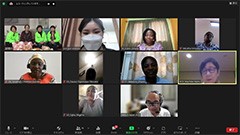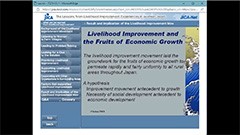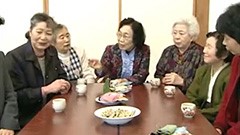- Home
- Our Work
- Types of Assistance
- Technical Cooperation
- Distance Technical Cooperation - JICA-Net
- JICA-Net multimedia-based learning materials Sample Activities
- JICA Tsukuba; Learn about the empowerment of rural women through Livelihood Improvement
JICA Tsukuba
Learn about the empowerment of rural women through Livelihood Improvement
Used the material in JICA Knowledge Co-Creation Program held by JICA Tsukuba
 12 participants from 7 countries (East Timor, Sri Lanka, Malawi, Nigeria, Zimbabwe, Guinea, and Ghana) participated in the program
12 participants from 7 countries (East Timor, Sri Lanka, Malawi, Nigeria, Zimbabwe, Guinea, and Ghana) participated in the program
JICA Tsukuba performed JICA Knowledge Co-Creation Program "Empowerment of Rural Women" (online program) from November 21st to December 21st, 2022.
The program has the purpose of "Learning the knowledge about the Livelihood Improvement Approach and the empowerment of rural women based on Japan's experiences".
12 participants from 7 countries (East Timor, Sri Lanka, Malawi, Nigeria, Zimbabwe, Guinea, and Ghana) participated in the program, of which were government officers, extension officers or specialists in charge of gender-related activities or extension activities for rural women.
In the course, we used JICA-Net multimedia-based learning material, "The Lessons from Livelihood Improvement Experiences in Postwar Japan". We consider that the contents are suitable for achieving the goal of the program and shared the URL of the video on JICA-VAN with participants as a self-learning material for the weekend.
Introducing the empowerment methods built by Japan's experiences to developing countries
 The contents of the material consist of 2 videos, a PowerPoint slide show, "Q&A", and "Glossary"
The contents of the material consist of 2 videos, a PowerPoint slide show, "Q&A", and "Glossary"
In developing countries, more than half of the population make a living by agriculture in rural regions, and there, women play an important role in agricultural labor. However, the improvement of women's abilities is hampered for various reasons, for example, compared to men, women have limited access to resources, a heavy burden of housework and childcare, and their activities are restricted by social and cultural factors.
In the past, Japan faced a similar problem as developing countries. However, Livelihood Improvement Approach and women's associations' activities, which fostered proactive rural women's groups through improvement activities of everyday lives, contributed to overcome the problem and achieve rural development.
The program aimed for participants in developing countries to learn Japan's experiences and the knowledge for empowerment of rural women mainly on the Livelihood Improvement Approach, and to acquire practical methods for supporting rural women in their own countries.
 Interviews from former livelihood improvement extension workers and rural woman.
Interviews from former livelihood improvement extension workers and rural woman.
We used the videos to achieve one of the module outputs, "Participants understand and explain the process of rural development in Japan and the Life Improvement Approach".
The contents of the material consist of 3 parts: "Japanese situation in 1940's" is a video that overviews the Japanese Livelihood Improvement Movement in the 1940s and 1950s, "What can be learned from livelihood improvement" is a PowerPoint slide show with narrated explanations, "Interview" is a video that includes interviews from former livelihood improvement extension workers and rural woman. In addition, "Q&A" and "Glossary" are included as supplements.
Among those, "Japanese situation in 1940's" (YouTube, external link) and "Interview" (YouTube, external link) are uploaded on JICA-Net Library YouTube Channel and everybody is able to watch them.
The knowledge that could be applied in various areas widely
Through viewing the material, participants were able to learn the way of developing an autonomous and sustainable group as well as methods for improving everyday life skills along with basic knowledge on utilization of rural resources.
This knowledge was effective for promoting participants' understanding in the discussion with former livelihood improvement extension workers during the program.
In the questionnaire results from participants, we received many responses about the value of learning the livelihood improvement approach. Moreover, the action plan made and presented by participants at the end of the program showed many solutions utilizing the method of the approach.
The material shows us the way of developing a sustainable group or the concrete method of income-generation activities organized by farmers. I believe that such knowledge and approach can be used not only in the field of gender and rural development but also projects in agriculture including SHEP (Smallholder Horticulture Empowerment & Promotion), agricultural extension and so on.
We hope that the material will widely be utilized for solving problems and promoting further development in developing countries.
NEMOTO Otome
JICA Tsukuba
*The Material(s) mainly applied
The Lessons from Livelihood Improvement Experiences in Postwar Japan
This material was made for Japanese organizations that help developing countries as a reference for their assistance work.
Currently, in each livelihood improvement project, there is a tendency to introduce improved kamados, as just an input activity, without considering the social context, and handicraft or food processing are introduced as a livelihood improvement project just because income improvement is the main objective. Therefore, this material is designed to deepen the understanding through example cases based on 5 key ideas: farm village development, poverty reduction, production activities compatible with the target group's lifestyle, participatory development, and synergetic effects between administrations and residents.

- Thematic Issues
- Types of Assistance
- Partnerships with Other Development Partners
- Climate Change / Environmental and Social Considerations
- Evaluations
- Compliance and
Anti-corruption - Science and Technology
Cooperation on Global
Issues - Research
- JICA Development Studies
Program / JICA Chair - Support for the Acceptance of Foreign HRs / Multicultural and Inclusive Community
- About JICA
- News & Features
- Countries & Regions
- Our Work
- Thematic Issues
- Types of Assistance
- Partnerships with Other Development Partners
- Climate Change / Environmental and Social Considerations
- Evaluations
- Compliance and Anti-corruption
- Science and Technology Cooperation on Global Issues
- Research
- JICA Development Studies Program / JICA Chair
- Support for the Acceptance of Foreign HRs / Multicultural and Inclusive Community
- Publications
- Investor Relations
